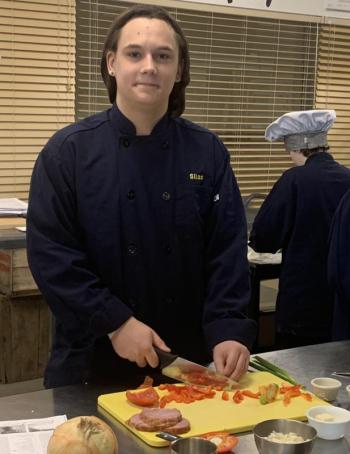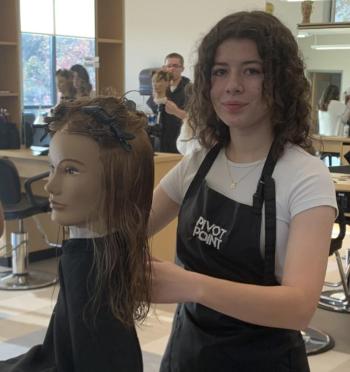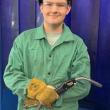More local students seeking trade school education
 Future carpenters Braden Davis, left, of Boothbay and Henry Putnam of Wiscasset are first-year students at Bath Regional Career and Technical Center. BILL PEARSON/Boothbay Register
Future carpenters Braden Davis, left, of Boothbay and Henry Putnam of Wiscasset are first-year students at Bath Regional Career and Technical Center. BILL PEARSON/Boothbay Register
 Silas Lehouillier is one of 26 Boothbay Region High School students enrolled in the two-year vocational program at Bath Regional Career and Technical Center. BILL PEARSON/Boothbay Register
Silas Lehouillier is one of 26 Boothbay Region High School students enrolled in the two-year vocational program at Bath Regional Career and Technical Center. BILL PEARSON/Boothbay Register
 BRHS junior Magen Burge is pursuing a career in cosmetology and is enrolled at Bath Regional Career and Technical Center. BILL PEARSON/Boothbay Register
BRHS junior Magen Burge is pursuing a career in cosmetology and is enrolled at Bath Regional Career and Technical Center. BILL PEARSON/Boothbay Register
 Brianna Farin is one of 26 Wiscasset High School students enrolled at Bath Regional Career and Technical Center. BILL PEARSON/Boothbay Register
Brianna Farin is one of 26 Wiscasset High School students enrolled at Bath Regional Career and Technical Center. BILL PEARSON/Boothbay Register
 Wiscasset junior Mason Gray has learned keeping a steady hand is mandatory for a future welder. BILL PEARSON/Boothbay Register
Wiscasset junior Mason Gray has learned keeping a steady hand is mandatory for a future welder. BILL PEARSON/Boothbay Register
 Future carpenters Braden Davis, left, of Boothbay and Henry Putnam of Wiscasset are first-year students at Bath Regional Career and Technical Center. BILL PEARSON/Boothbay Register
Future carpenters Braden Davis, left, of Boothbay and Henry Putnam of Wiscasset are first-year students at Bath Regional Career and Technical Center. BILL PEARSON/Boothbay Register
 Silas Lehouillier is one of 26 Boothbay Region High School students enrolled in the two-year vocational program at Bath Regional Career and Technical Center. BILL PEARSON/Boothbay Register
Silas Lehouillier is one of 26 Boothbay Region High School students enrolled in the two-year vocational program at Bath Regional Career and Technical Center. BILL PEARSON/Boothbay Register
 BRHS junior Magen Burge is pursuing a career in cosmetology and is enrolled at Bath Regional Career and Technical Center. BILL PEARSON/Boothbay Register
BRHS junior Magen Burge is pursuing a career in cosmetology and is enrolled at Bath Regional Career and Technical Center. BILL PEARSON/Boothbay Register
 Brianna Farin is one of 26 Wiscasset High School students enrolled at Bath Regional Career and Technical Center. BILL PEARSON/Boothbay Register
Brianna Farin is one of 26 Wiscasset High School students enrolled at Bath Regional Career and Technical Center. BILL PEARSON/Boothbay Register
 Wiscasset junior Mason Gray has learned keeping a steady hand is mandatory for a future welder. BILL PEARSON/Boothbay Register
Wiscasset junior Mason Gray has learned keeping a steady hand is mandatory for a future welder. BILL PEARSON/Boothbay Register
Silas Lehouillier of Edgecomb is a high school junior who knows his way around a kitchen. He has cooked with his family members since he was a child. His favorite dish to prepare is curry. He knows all about chopping vegetables, selecting the right spices and mixing them all with his protein of choice, most likely chicken, into a bowl then adding cream or coconut milk, and letting it settle into a delicious dish.
“I like food and I like to make food,” Lehouillier said. He is now looking to develop his hobby into a career. His future plans include either teaching or working in the culinary field.
Lehouillier is one of 26 Boothbay Region and 26 Wiscasset high school students attending the two-year vocational program at Bath Regional Career and Technical Center. So why has Lehouillier decided on a culinary career? “I started in the kitchen cooking with my family and really enjoyed it. It’s like a perfect mix of science and your own creativity in a really nice way,” he said.
Lehouillier is part of a trend over the past seven years of students increasingly gravitating toward technical education. He is one of 302 students enrolled at Bath Regional Career and Technical Center. The school offers 11 career and technical education courses to Midcoast high school students enrolled at Morse, Boothbay, Lincoln Academy and Wiscasset high schools. In 2017, Bath Tech Center enrollment was 167. It now has 135 more students, a 38% increase.
One reason for the dramatic increase is Bath Tech Center’s size. In 2020, midway through the school year, the new Morse High School opened which included a larger technical center inside. More space and programs aided the center’s popularity. Programming expanded adding cosmetology and law enforcement to the other nine programs (Automotive, Carpentry, Graphic Design, Culinary Arts, Electricity Technology, Design and Fab Exploration, Early Childhood, Health 1 CNA, Medical Science, and Welding).
Cosmetology is the second-most popular program with 32 students trailing carpentry with 33. It is not hard to understand why students want to pursue technical education, according to Bath Career and Technical Center Director Julie Kenny. “It gets them into the workforce faster than a four-year post-secondary education and it’s less expensive.”
Kenny is also not surprised at the rapid growth of the new cosmetology program. She described cosmetology as a “money-making machine.” At Bath, the various tech programs provide 750 hours of training over two years. When students finish high school, they receive a certificate to show future employers or earn college credit.
Magen Burge is a junior from Boothbay enrolled in the cosmetology program. As a first-year student, she is learning about haircuts. She became interested in cosmetology as a youth. Burge said the program is “super fun” and she has learned a lot in her early classes. She has also learned one unexpected lesson. “I thought it would be easy, but it’s not. You learn a lot by trial and error,” she said.
After high school, she plans on attending Paul Mitchell Hair and Beauty School in Sarasota, Florida. Kenny said beauty school students can earn their state certification after eight to nine months of advanced study. Burge will consider her options after she receives her beautician’s license. “I’m looking forward to opening my own business someday in Florida,” she said.
Brianna Farrin of Wiscasset is another first-year cosmetology student. After graduation, she plans on staying closer to home. She plans to enroll at Aveda Institute Maine in Augusta. “I love to do nails, and I thought this would be a good future for me,” she said. Entering the workforce after less than a year of post-secondary education appeals to her. So does owning her own shop.
Wiscasset junior Mason Gray is one of 27 students in the welding program. His father works at Bath Iron Works and introduced him to the trade. As a first-year student, he is learning about inert metal gas (MIG) welding. An early important lesson is a steady hand. “It’s a little gun with a trigger which spits out wire when it touches the metal and gas comes out,” he said. “You really got to concentrate on keeping the bead looking good. It’s hard keeping them straight and flat.” Gray plans on attending Kennebec Valley Community College to earn his commercial driver’s license for operating heavy equipment. After college, he plans on moving south to work as a welder.
Braden Davis of Boothbay and Henry Putnam of Wiscasset are both in the carpentry program. Both students’ families have a tradition of carpentry which they both intend to pursue. The two-year program teaches students how to build a house in a two-year period. After graduation, both Davis and Putnam have an option to work with their fathers. “I may go to a trade school, if it’s free,” Putnam said. “If not, I will work with my dad.”
Davis does not have any specific plans post-graduation. “I might go to college. I don’t know,” Davis said. “I might stay in the area or move south.”
Jericho Adler is an educational technician with the carpentry program. He previously taught general math at Morse High School. As an ed tech, he assists program director Ray Bernier with keeping the students on task, but that is not as big a problem as you might think. Adler has seen a major difference between vocational and academic students. “It’s a different group of kids,” he said. “I’ve noticed a lot more interest and passion with the carpentry program. I had kids yesterday, who said ‘If we don’t finish the roof today, then we will stay until we do.’ I don’t remember anything like that happening when I taught math,” he said.
Since 2017, Boothbay’s enrollment to Bath Tech has increased from 15 to 26. Wiscasset’s has jumped from 17 to 26.






























